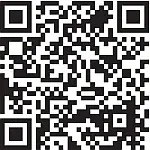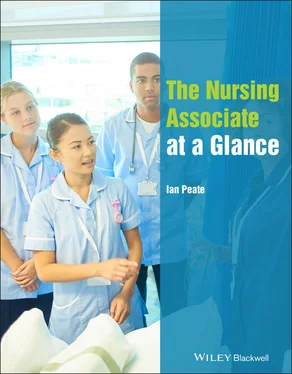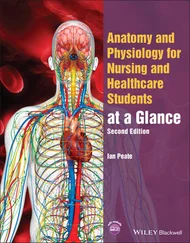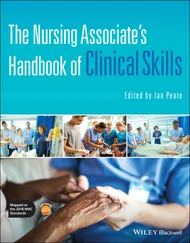98 93
99 94
100 95
101 96
102 97
103 98
104 99
105 100
106 101
107 102
108 103
109 104
110 105
111 106
112 107
113 108
114 109
115 110
116 111
117 112
118 113
119 114
120 115
121 116
122 117
123 118
124 119
125 120
126 121
127 122
128 123
129 124
130 125
131 126
132 127
133 128
134 129
135 130
136 131
137 132
138 133
139 134
140 135
141 136
142 137
143 138
144 139
145 140
146 141
147 142
148 143
149 144
150 145
151 146
152 147
153 148
154 149
155 150
156 151
157 152
158 153
159 154
160 155
161 156
162 157
163 158
164 159
This title is also available as an e-book.
For more details, please see
www.wiley.com/buy/9781119724308or scan this QR code:

The Nursing Associate at a Glance
Ian Peate OBE FRCN
Principal, School of Health Studies
Gibraltar Health Authority
Gibraltar

This edition first published 2021
© 2021 John Wiley & Sons Ltd
All rights reserved. No part of this publication may be reproduced, stored in a retrieval system or transmitted, in any form or by any means, electronic, mechanical, photocopying, recording or otherwise, except as permitted by law. Advice on how to obtain permission to reuse material from this title is available at http://www.wiley.com/go/permissions.
The right of Ian Peate to be identified as the author of this work has been asserted in accordance with law.
Registered Office(s) John Wiley & Sons, Inc., 111 River Street, Hoboken, NJ 07030, USA John Wiley & Sons Ltd, The Atrium, Southern Gate, Chichester, West Sussex, PO19 8SQ, UK
Editorial Office 9600 Garsington Road, Oxford, OX4 2DQ, UK
For details of our global editorial offices, customer services, and more information about Wiley products, visit us at www.wiley.com.
Wiley also publishes its books in a variety of electronic formats and by print‐on‐demand. Some content that appears in standard print versions of this book may not be available in other formats.
Limit of Liability/Disclaimer of Warranty The contents of this work are intended to further general scientific research, understanding and discussion only, and are not intended and should not be relied upon as recommending or promoting scientific method, diagnosis or treatment by physicians for any particular patient. In view of ongoing research, equipment modifications, changes in governmental regulations and the constant flow of information relating to the use of medicines, equipment and devices, the reader is urged to review and evaluate the information provided in the package insert or instructions for each medicine, equipment or device for, among other things, any changes in the instructions or indication of usage and for added warnings and precautions. While the publisher and authors have used their best efforts in preparing this work, they make no representations or warranties with respect to the accuracy or completeness of the contents of this work and specifically disclaim all warranties, including without limitation any implied warranties of merchantability or fitness for a particular purpose. No warranty may be created or extended by sales representatives, written sales materials or promotional statements for this work. The fact that an organisation, website or product is referred to in this work as a citation and/or potential source of further information does not mean that the publisher and authors endorse the information or services the organisation, website or product may provide or recommendations it may make. This work is sold with the understanding that the publisher is not engaged in rendering professional services. The advice and strategies contained herein may not be suitable for your situation. You should consult with a specialist where appropriate. Further, readers should be aware that websites listed in this work may have changed or disappeared between when this work was written and when it is read. Neither the publisher nor authors shall be liable for any loss of profit or any other commercial damages, including but not limited to special, incidental, consequential or other damages.
Library of Congress Cataloging‐in‐Publication Data
Names: Peate, Ian, author.
Title: The nursing associate at a glance / Ian Peate.
Other titles: At a glance series (Oxford, England)
Description: Hoboken, NJ : Wiley‐Blackwell, 2021. | Series: At a glance series | Includes bibliographical references and index.
Identifiers: LCCN 2021008652 (print) | LCCN 2021008653 (ebook) | ISBN 9781119724308 (paperback) | ISBN 9781119724360 (adobe pdf) | ISBN 9781119724353 (epub)
Subjects: MESH: Nursing Assistants | Nursing Care–methods | Nurse’s Role | United Kingdom | Handbook
Classification: LCC RT41 (print) | LCC RT41 (ebook) | NLM WY 49 | DDC 610.73–dc23
LC record available at https://lccn.loc.gov/2021008652LC ebook record available at https://lccn.loc.gov/2021008653
Cover Design: Wiley
Cover Image: © sturti/iStock/Getty Images
Nursing, being a practice‐based discipline, requires the theoretical knowledge provided to be grounded in practice so as to facilitate professional competence with regard to fitness for practice, purpose, award as well as professional standing.
The role of the Nursing Associate was developed in response to a number of key policies and drivers, including the NHS Five Year Forward Plan (NHS, 2014), Shape of Caring: Raising the Bar (Health Education England (HEE) 2015), Nursing Associate Curriculum Framework (HEE, 2017) and the Skills for Health (2017) Nursing Associate Apprenticeship Standards. The Nursing and Midwifery Council (NMC) confirmed in January 2017 that the Nursing Associate will be a new regulated nursing role, in England, from January 2019.
In response to the NMC’s confirmation that it would become the Nursing Associate regulator, actions needed to be taken to ensure that standards were in place. Standards were produced in 2018 for the Nursing Associate proficiencies (NMC, 2018a) and for Nursing Associate programmes (NMC, 2018b). The NMC revised its Code of Conduct in 2018 to include the Nursing Associate (NMC, 2018c).
Locally, nationally and globally, health and care settings are experiencing complex challenges. There has been an increased demand on services with the imperative that patients receive the right care, at the right time and in the right place. Key to this is the building of new health and care partnerships, integrating care provision and developing new roles. The Nursing Associate role is a response to the need to develop the healthcare support worker role and to offer support to the Registered Nurse. A role in its own right, the Nursing Associate acts as a bridge between, and complements, the unregulated healthcare workforce and the Registered Nurse. Furthermore, it widens access to further career development as a Registered Nurse.
Approved Nursing Associate programmes are aimed at individuals who are employed in health and care settings. Programmes of study have to be flexible, authentic work‐based learning programmes that develop competent, confident and compassionate Nursing Associates who will be proficient in the provision of high‐quality, safe and responsive person‐centred care that traverses the lifespan in a variety of diverse settings. As programmes of study involve learning from practice , and learning in practice , they draw upon the principles of work‐based learning in supportive environments.
Читать дальше














